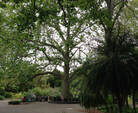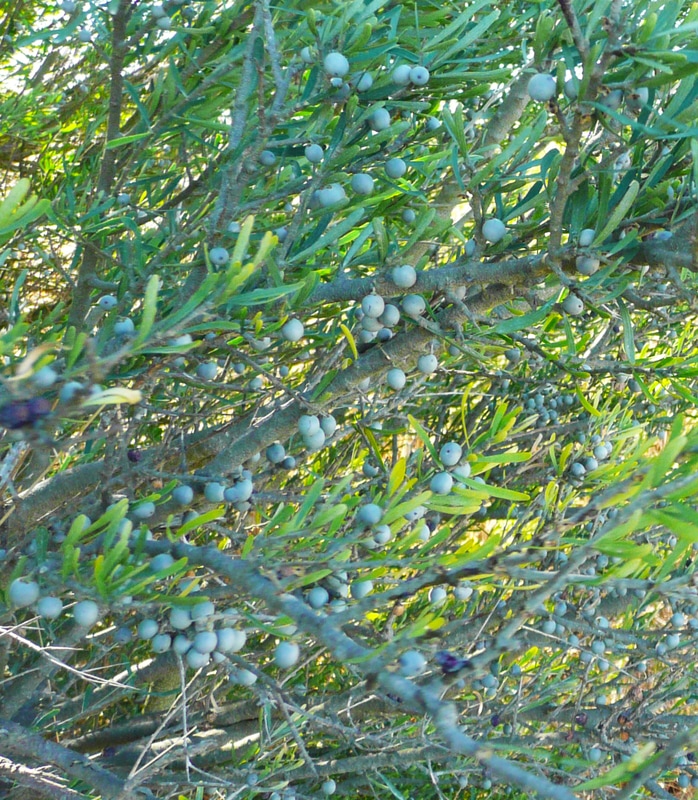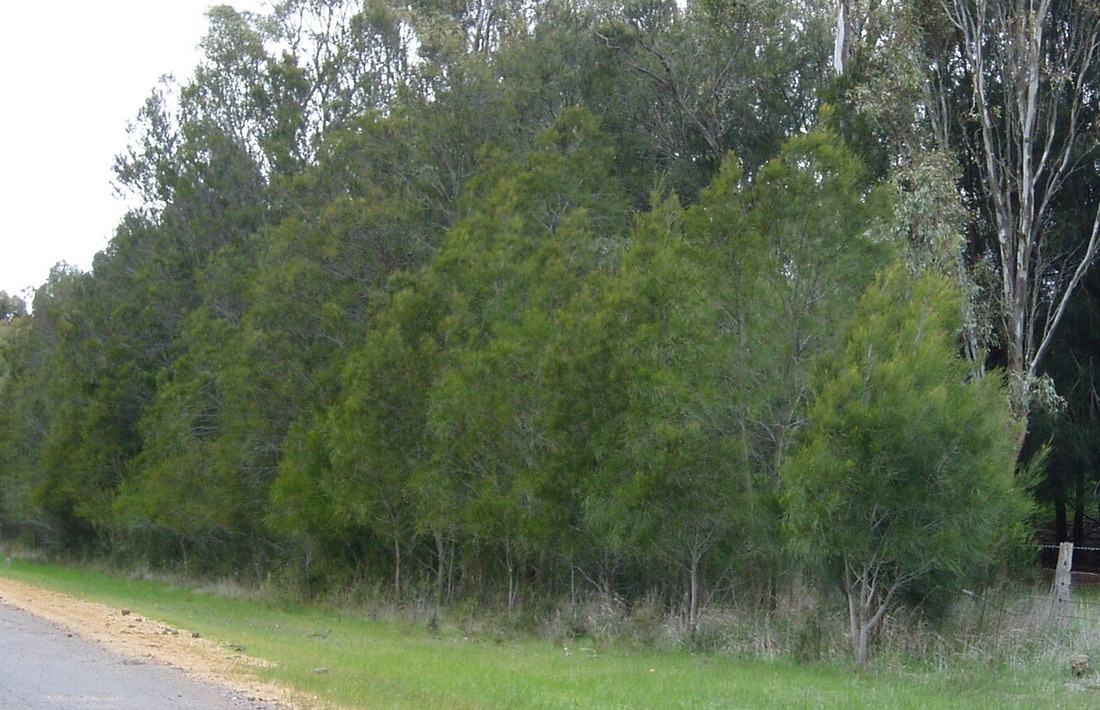Recreating the Country blog |
 A well managed plantation can protect a farm from bushfire A well managed plantation can protect a farm from bushfire When thinking about farm plantations and bushfires, the potential benefits are maximised if a plantation is well positioned, well designed and well managed. To help you ease into this important topic, this blog follows three lines of discussion;
Native farm plantations provide many benefits to a property including increased biodiversity, wind shelter for stock and crops, shade, drought fodder, timber for firewood, construction and craft and so on. I have a slide of twenty benefits that I show at Landcare presentations. One benefit that isn’t mentioned often is the potential for farm plantations to protect a property from bushfires.  Native plantations reduce wind velocities and slow the advance of bushfires Native plantations reduce wind velocities and slow the advance of bushfires Fire protection benefits of native plantations The key benefits of plantations are; 1. Slowing the progress of a fire by reducing wind velocities. A fire may be stopped by a plantation or it will move at a slower speed if it spreads to the wind protected side. If wind velocities are 50% reduced then the fire will be moving at half its former speed within the wind protected zone of the plantation. This protected zone/distance from a plantation is generally 20 x its height. So a 20 meter tall plantation will reduce wind velocities and slow the progress of a fire over a 400 meter wide zone from the plantation edge. A note on design of windbreaks near a house or sheds: When designing native windbreaks near a house or sheds that include trees over 20 m tall, keep trees at the recommended safe distance of 30 meters - 1.5 times x maximum height from any building assets like a house and sheds. For wider plantations (25 – 50 meters) consider planting tall trees on the side of the plantation away from the house and sheds to keep them at a safe distance. This will dramatically reduce dead leaves blowing into guttering and building up around buildings which adds to the properties fire risk. For the best wind protection a windbreak’s length should be at least 20 times the tallest tree height to be effective and meet at paddock corners to provide good protection if the wind and fire change direction. So a 20 meter maximum height windbreak would ideally be 400 meters long and form a T or L shape with another plantation at the north-western and south-western corners of a paddock for the optimum wind and fire protection allowing for westerly wind changes turning a fire. For smaller properties plantations 50 - 100 m long on the northern and western boundaries will provide adequate protection if the wind changes from the north to the west or south west.  A native plantation will absorb radiant heat and trap glowing embers. CFA graphic A native plantation will absorb radiant heat and trap glowing embers. CFA graphic 2. Reducing damaging radiant heat. The CFA website describes radiant heat as ‘the heat you feel from a fire' and describes it as 'the biggest killer in a fire'. They add that the best protection is distance. If you can’t distance yourself from a grass or bush fire, a vegetation barrier is a very effective shield from radiant heat. As mentioned in the February blog, deciduous trees provide a safer vegetation screen from radiant heat because they are less flammable than most native plants, however a native plantation with good shrub and understorey layers will dramatically reduce the radiant heat transferred beyond the plantation. 3. Trapping embers from approaching fires. Many of the glowing embers carried by strong winds will drop to the ground when the wind velocity decreases at a plantation. The condition of the ground layer will then determine whether the embers will start a fire within the plantation or burn out.  A cool burn is best defined by the slow travel speed of the fire travels (0.4 – 3 meters/minute) and the fire's low flame height (0.2 – 0.8 meters). A cool burn is best defined by the slow travel speed of the fire travels (0.4 – 3 meters/minute) and the fire's low flame height (0.2 – 0.8 meters). Plantation management to minimise fire risk A cool burn through a plantation in April & May will reduce the fine fuel loads on and near the ground in the summer fire season. This burning cycle can vary between 3 – 15 years and depends on the build-up of fine fuel on the ground. A cool burn is best defined by the speed that the fire travels (0.4 – 3 meters/minute) and the fires flame height (0.2 – 0.8 meters). Burning late in the day when the dew is starting to dampen the leaf litter helps to keep the fire from heating up. A cool burn will ‘clean up’ the fine fuels and regenerate some plant species like the acacias that need fire to germinate their seed. A cool burn is safe and simple to manage with a damp hessian sack or even an acacia branch which is used to ‘swat out’ any fire that is spreading where it’s not wanted. A good cool burn will be patchy, leaving unburnt areas of leaf litter behind logs and rocks as refuges and as a source of food for resident frogs, lizards and ground feeding mammals and birds while the burnt areas recover. The wildlife population living in a plantation will recover and often expand within two years after a patchy cool burn because of the increased plant diversity it generates. Choosing native species that are less flammable Features of plants that make them less flammable include leaves with; - high salt content - high moisture content - low volatile oil content - high ash content (makes plants harder to ignite) Large broad leaves are also harder to ignite than narrow leaves. - Smooth tight bark Eucalypts All eucalypts have low leaf moisture when compared to deciduous trees, as well as a low ash content, which makes them easier to ignite. Eucalypts also have over 4% volatile oil in their leaves which can ignite at temperatures as low as 60 degrees C. For comparison, deciduous trees have less than 0.1% volatile oils in their leaves and wattles, grevilleas and hakeas have less than 1%. Eucalypt species with loose ribbons of bark or open fibrous stringy bark are more of a fire risk because fire can move up the trunks into the flammable volatile oil rich leafy canopy. Species like the Manna/Ribbon Gum, Eucalyptus viminalis, Swamp Gum, E. ovata, Southern Blue Gum, E. globulus and Mountain Ash, E. regnans all have loose ribbons of bark, and are an important source of food for birds, possums and gliders, but a risk if planted near a home or sheds. Also, risky because of their flammable fibrous bark are the stringy bark eucalypts like Messmate, E. obliqua and Red Stringybark, E. macrorhincha. Hard rough bark eucalypts like the ‘Box’ species, the Ironbarks, Eucalyptus sideroxylon and E. tricarpa and smooth, patchy sometimes scaly bark species like River Red Gum, E. camaldulensis are classified as a ‘moderate’ fire risk in the Victorian Government’s ‘Overall fuel hazard assessment guide – 4th edition’. Smooth bark eucalypts are classified as a ‘low’ fire risk and therefore a better choice near buildings because fire can’t travel up the trunk to the canopy and ignite the oil rich leaves. These species include Spotted Gum, Corymbia maculata, Lemon Scented Gum, C. citriodora, Sydney Bluegum, Eucalyptus saligna, Sugar Gum, E. cladocalyx and Smooth-bark Apple, Angophora costata. Other plants with high volatile oils in their leaves are callistemon species (bottlebrush), leptospermum sp. (teatree), melaleuca sp. (paperbark) and prostanthera sp. (mint bush). These are all beautiful plants but present more of a fire risk because of the volatility of their leaves if planted near a house or sheds Native species that are a lower fire risk because they have;
atriplex sp. (salt-bush – also have the added benefit of high leaf salt content) banksia sp.; brachychiton sp. (kurrajong); casuarina & allocasuarina sp. (sheoak); Dodonaea viscosa, Wedge-leaf Hop-bush; grevillea sp.; hakea sp.; Melycitus dentatus, Tree Violet; Myoporum viscosum, Boobialla (high moisture and the added benefit of very high ash leaf content); olearia sp. (daisy-bush); pomederris sp.; rhagodia sp. (salt-bush – also have the added benefit of high leaf salt content) solanacea sp. (Kangaroo Apple). Leaf size and moisture are important Choose species from this group of plants that have large ‘soft’ leaves and avoid plants with small, narrow, hard, dry leaves when planting near your family home and sheds.
 The groundcover Nodding Saltbush, Einadia nutans showing the typical fire resistance of the Saltbush family The groundcover Nodding Saltbush, Einadia nutans showing the typical fire resistance of the Saltbush family All plantations, whether they are planted for wind shelter, firewood, forestry or to improve biodiversity will reduce the fire risk on farms by slowing down damaging winds. Including a diverse mix of plants with low flammability such as shrubs, understorey and canopy trees will significantly reduce the radiant heat transferred beyond the plantation and provide wind shelter over a large area of the adjacent paddocks. Maintenance of the ground layer with regular cool burns will protect windbreaks from the damage a major hot fire can cause to a plantation and make them even more of an asset on fire danger days. Have a look at this article for lists of plants that have been observed to be fire retarding and fire resistant; apsvic.org.au/fire-resistant-and-retardant-plants/  You may also like these blogs on plants and bushfire protection;  
4 Comments
Tracy Kelly
29/9/2019 08:21:07 am
Thank you for the fabulous info in the above article. I live next to a paperback swamp and always worry about bushfires. I have been planting for a year now and trying to find info on best plants etc. So it seems some of my choices have been great😁. I am now thinking about digging up the 4 bottle brush I planted and think about something different in their place.
Reply
Steve
8/10/2019 08:04:58 am
Hi Tracy,
Reply
Debra O'Brien
3/8/2021 09:54:59 pm
Are sugar gums suitable for deep planting? What other species would be suitable for this type of planting. I want to plant a wind break and we don't have much water to look after them
Reply
Steve
4/8/2021 02:59:09 pm
HI Debra,
Reply
Leave a Reply. |
Click on the image below to discover 'Recreating the Country' the book.
Stephen Murphy is an author, an ecologist and a nurseryman. He has been a designer of natural landscapes for over 30 years. He loves the bush, supports Landcare and is a volunteer helping to conserve local reserves.
He continues to write about ecology, natural history and sustainable biorich landscape design. 
|














 RSS Feed
RSS Feed
